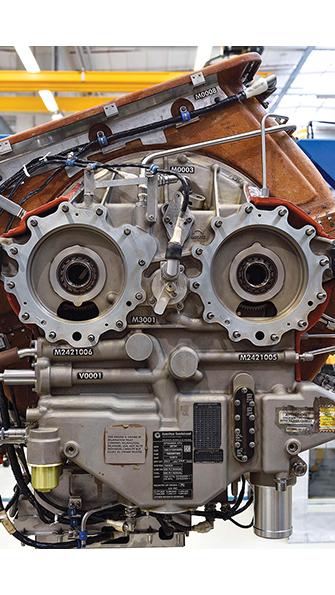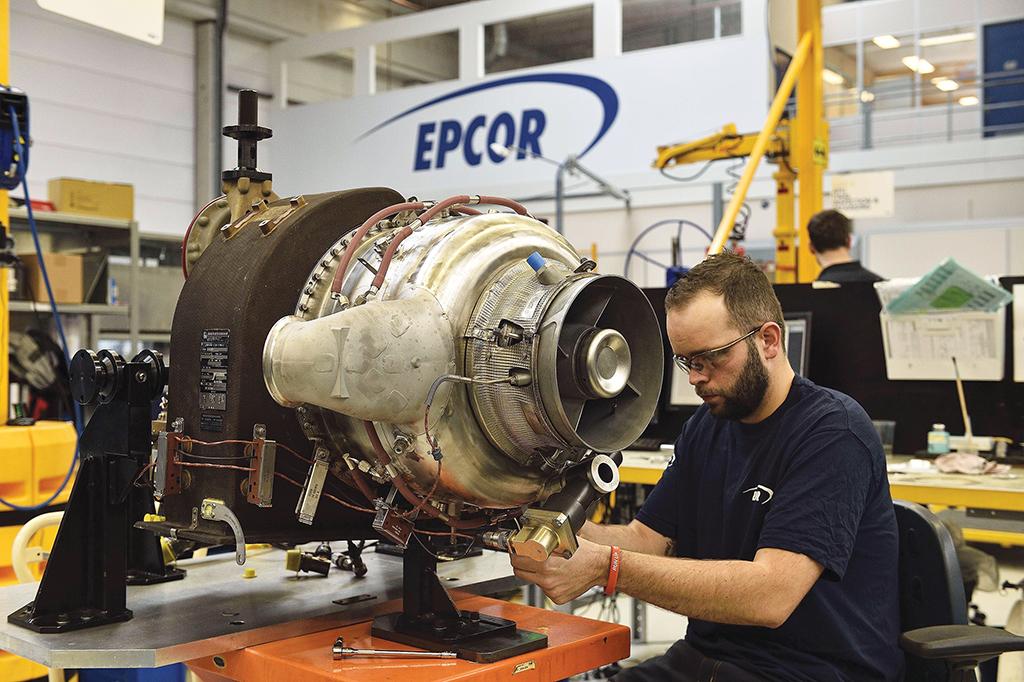
The traditional role of the auxiliary power unit (APU) has been to provide electrical power and pneumatic supply for air conditioning and main-engine starting when aircraft are on the tarmac. That generally remains the case, although the Boeing 787 uses an APU that provides only an electrical supply, as the aircraft was designed with a bleedless architecture that does away with traditional pneumatic systems.
The usually unseen gas turbine behind an aircraft’s exhaust cone also provides emergency electrical power and pneumatic supply in the event of a primary aircraft system failure. Although the unit is rarely used in this context, it did provide the humble APU with its only Hollywood moment during the film based on the ditching of US Airways Flight 1549 in New York’s Hudson River. The movie “Sully” depicted how the aircraft’s captain switched on the Airbus A320’s APU to provide power for its control surfaces after a double engine failure, helping him to land safely on the river.
APU Maintenance
Under normal circumstances, APU failures mean that aircraft must hook up to ground-based power and pneumatic supplies. Consequently, regular APU maintenance can be neglected by operators, at least compared with the stringent regimes applied to main engines. Furthermore, while under-wing engines provide multiple sensor readings that can warn of problems, sometimes the only indication of APU damage is a loss of bleed pressure or increase in exhaust-gas temperature. As a result, it is not uncommon for APUs to reach the overhaul shop in a severely degraded condition.
Typical faults include compressor and hot-section degradation, especially if the APUs have been operating in hot climates. High ambient temperatures can lead to high exhaust-gas temperature margins, especially in APUs with many hours or cycles, and can also require additional fuel to meet performance requirements.
The typical workflow of a shop visit comprises a borescope inspection followed by a preliminary test run, if feasible. Then the unit is stripped, cleaned, inspected and reassembled, with component repairs and replacements performed according to customer specifications. Static and dynamic balancing of core rotating components is also a key step in the overhaul process. After reassembly, the APU is tested to ensure it is performing to OEM specifications.
COVID-19 Impact
As airlines have parked large portions of their fleets during the COVID-19 crisis, demand for maintenance has plummeted across all components, including APUs. Leading APU manufacturer Honeywell reported that commercial aircraft aftermarket revenues—which include components other than APUs—were down 48% year-over-year in the fourth quarter of 2020 and 55% in the third quarter.
“COVID has had a significant impact on the flow of APUs coming to our shop,” says Martijn de Vries, managing director of EPCOR, the Air France Industries KLM Engineering & Maintenance (AFI KLM E&M) subsidiary that focuses on maintenance and overhaul of APUs and certain other components.
Regarding the type of work performed, he adds that although workscopes have not varied too much as a result of the pandemic, “we have incidentally been requested to look into limited workscopes in relation to cash savings and lease-return demands.”

EPCOR’s APU capabilities cover the Honeywell GTCP 131-9 variants for Boeing and Airbus single-aisle aircraft, the GTCP 331-350 for the A330/A340, the GTCP 331-500 for the Boeing 777, the Pratt & Whitney APS5000 for the 787, the APS3200 for A320-family aircraft, and the APS2300 for Embraer 170 and 190 aircraft.
De Vries notes that due to the variety of aircraft types as well as a mix of flight-hour-based and time-and-materials contracts, the impact of the pandemic on APU maintenance has been uneven, although he is optimistic about seeing some near-term improvement. “Overall, we see some recovery. . . . We expect that airlines with a higher aircraft utilization will send their delayed-maintenance APUs for repair with the summer ahead of us.”
De Vries also observes that the used parts market for APUs has remained relatively steady through the pandemic, although he has noticed an uptick in units offered on an “as-is” basis due to more phase-outs and teardowns of older widebody aircraft.
However, the large numbers of aircraft put into temporary or long-term storage during the crisis has had a more noticeable impact, he says. “A result of low aircraft/APU utilization are increasing reports of corrosion due to inadequate preservation. This corrosion leads to low-time removals and is, as such, a new phenomenon,” he notes.
Reliability Improvements
De Vries says that the incorporation of certain service bulletins (SB) has led to fewer shop visits as APU reliability has increased. A notable example has been the 787’s APS5000, which does not have the traditional load compressor but sports two generators to support its extra electrical output. “As the design was somewhat new, the reliability has been improved with SBs over the past years,” he says.
The Honeywell and Pratt & Whitney APUs for the most popular narrowbodies feature computerized controls that shut down the units to avoid damage to the gas turbine if certain limits are breached. In October 2020, Honeywell released a software update for its GTCP 131-9A line designed to increase time on wing by 1,200 flight hours and reduce fuel burn by 2%.
“This upgrade is an easy, one-time modification enabled with software and will be available first for our Maintenance Service Plan customers and later for all operators of 131-9A units,” says David Shilliday, vice president of engines and power systems at Honeywell Aerospace. The upgrade can be installed during scheduled maintenance event and does not require additional downtime.
Meanwhile, De Vries notes that the trend-monitoring of computer-controlled APUs can feed into big-data analysis and predictive maintenance. To pursue this, EPCOR has developed proprietary algorithms within its Prognos for APUs platform, which offers predictive maintenance for almost all of the APUs that it services.
Starting with possible APU failure modes, Prognos seeks to determine the combination of sensors that help predict them. These vary by both APU type and operating conditions, although common findings are bearing failure and carbon-seal failure. Typical actions based on Prognos warnings are inspections or removals of either APUs or their components, with one of the main goals being the avoidance of the severe damage that can occur in the final minutes of an APU failure.
“The system, based on big data, allows the APU to be monitored and helps airlines to maintain maximum control over their assets, keeping them operating for as long as possible with minimal effort,” says De Vries.
Adaptation to Alternative Fuels
As sustainability concerns gain traction in global aviation, the use of alternative fuels is likely to become more widespread. One of these is sustainable aviation fuel, which can be used in both main engines and APUs. “At EPCOR, we test our APUs partly with sustainable aviation fuel, and we continuously search for new innovations that lower our environmental footprint,” De Vries explains.
Even greater emission reductions are expected from a switch to electric and hybrid-electric propulsion, even if doubts remain about whether the technology is feasible for powering narrowbody-size aircraft. Nevertheless, Honeywell is developing a 1-megawatt generator that can be combined with its HGT1700 APU, which flies on the Airbus A350, to make a turbo-generator to power electric motors or batteries on smaller craft such as heavy-lift cargo drones, air taxis and commuter aircraft. The turbo-generator can run on normal fuel or biofuel.
Aftermarket Recovery
De Vries expects APU maintenance demand to recover in line with the return to service of the global airline fleet. Accordingly, one would predict that shop visits for narrowbody and regional aircraft APUs will pick up first, followed by the widebody segment.
Less certain is the extent to which airlines will phase out older aircraft in favor of new-generation models as traffic recovers. For APU shops, this trend may have a limited effect given that the A320neo and A320, as well as the 737 MAX and 737NG, share the same APU types, but investment in new capabilities may be required across other aircraft families.
During the pandemic, EPCOR acquired two new licenses: the sole global license for the GTCP 331-350 used by the A330neo and the sole license in Europe, the Middle East and Africa for the GTCP 131-9C used on the Airbus A220. It now has capabilities across eight APU types.






Comments